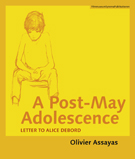“At the crossroads of art and politics”
Let’s just say I was the exact opposite of an outcast, since it was precisely inclusion that most horrified me. (Assayas, 34-5)
The younger Olivier Assayas seems a little lost, as he struggles to resolve the contradictions between a desire to paint and his love of situationist thinking. A Post-May Adolescence: A letter to Alice Debord is a recollection of the impact May ’68 had on Assayas, when he was still only thirteen, and his subsequent search for “the expression of [his] era’s radicality.”(49)
Along with an introduction by Adrian Martin that places the recollections in the context of Assayas’ later filmmaking, this first English translation of Assayas’ memoir also includes “The Hidden Oeuvre”, written by Assayas at the time of the re-release of Guy Debord’s films in 1994. This essay reminds us of the subtlety of Debord’s situationist writings, his humour and his cheekiness, a perspective often lacking in other commentaries. Debord’s insistence on the inseparability of thinking and practice, which he combined with the skill of siphoning from the historical moment the most appropriate and precise action for the times is perhaps the best place to locate Assayas’ own story. Even if at times it is unashamedly polemic, and at other times a little sad and a little acquiescing, it is a refreshing read for those exhausted by the pretence of objectivity that is assumed by more conventional ‘histories’…
Yet it was not for want of conviction, or even lucidity, in the face of the general collapse of which I was a spectator, before which we were all spectators…we accepted the bargain — here shake on it — of personal achievement via a circumscribed approximate realization of certain theoretical objectives: life as a journey, irony as playful distance, and the world as a game: there’s nothing we can do about it, we’re guilty of nothing, we’re nobody’s fools, we know it all but do nothing because we’re not involved and we don’t want to be. Salvation meant surfing the present, and never peering into the abyss.(49)
In its tracing of a singular story, it is also capable of speaking more widely, intuitively, for it offers in that wonderfully Walter Benjaminian way a possible path into the past that reflects sharply on the present, while resisting the often arrogant and reductionist ‘judgements’ of the ‘expert’. For Assayas was never an actor at the heart of things. His recollections of May ’68 are refracted through his absent teachers, the media, or reports brought back from the centre of Paris by his father.
At one point he observed: “So there I was on the periphery (in all senses of the word)”.(13) Regardless of the temporal, geographical and cultural remoteness of Assayas’ memories, they felt strangely familiar. He describes growing up in the 1970s with the same sour taste and sense of lack that my friends and I felt in the distant and much duller suburbs of Melbourne. It seems that travelling not with the rise of a series of historically significant events, but only after their strongest effect had already begun to ebb was felt widely across my generation. And we voiced a similar sense of disappointment with collectives:
And lastly you had the unorganised, such as myself, in whom an extreme, barely articulate radicality replaced any kind of platform. (22)
As well as organised leftist movements, we also had the doctrinarian demands of hippies in our targets. And we did this while paradoxically bemoaning the collapse of the Western world’s desire for collectivism. As the impulse for ‘revolution’ dissolved in the 1970s (“the years of lead” as Assayas dubs them) into individualistic cells of self-interest and consumerism, we also waited for our political disappointment to meet its aesthetic equivalent in the exalting nihilism of punk.
I didn’t choose [the years of 1970s] and I am returning to them. This violent, confused and contradictory period, overshadowed by the events of May 1968, continues to be the object of misunderstandings. I experienced those years and I am their worst witness…[1]
A Post-May Adolescence is a timely publication, for it coincides with Assayas’ latest film project, Après mai (2012), set in the same period, with familiar protagonists, and for which Assayas won best screenplay at Venice this year.[2] Assayas’ perspective on this time, reminds us that we survive today with the essential contradictions and paradoxes of capitalism more firmly in place. The way through For Assayas is filmmaking.
I was reminded when reading Assayas that long before politics ‘proper’ has furnished us with the appropriate language and systems of thought, much more powerful allegiances, far less concrete or locatable have already begun to shape us. I found this to be one of the most interesting aspects of the essay: how one is destined in some way to covert a type of politics, or a form of boredom, or a type of disappointment with the world that is first aesthetic and sensate, prior to forming a logical system or set of intellectual discourses to accompany them. Of course, for most of us, for Assayas, it is the taste for a constellation of cultural forces — music, film, a natural wont for resistance, a need for change — that first attracts us. It seems that Assayas was already on this path by the time he found Orwell, Warhol, the Velvet Underground, the situationists…
[1] Taken from Olivier Assayas, Director’s Statement to accompany Après mai, Venezia 69, http://www.labiennale.org/en/cinema/festival/lineup/off-sel/venezia69/apres-mai.html, accessed November 2, 2012
[2] Après mai will be released in Australia by Palace Films in 2013.

